Services on Demand
Journal
Article
Indicators
-
 Cited by SciELO
Cited by SciELO -
 Access statistics
Access statistics
Related links
-
 Cited by Google
Cited by Google -
 Similars in
SciELO
Similars in
SciELO -
 Similars in Google
Similars in Google
Share
Universitas Psychologica
Print version ISSN 1657-9267
Univ. Psychol. vol.13 no.4 Bogotá Oct./Dec. 2014
https://doi.org/10.11144/Javeriana.UPSY13-4.psdw
A Pilot Study Designing a Website to Enhance the Well-Being of Caregivers of Children with Cerebral Palsy*
Estudio piloto de diseño de un sitio web para el bienestar de cuidadores de niños con parálisis cerebral
Mercê Boixadòs**
Benigna Gómez-Zúñiga
Eulália Hernández-Encuentra
Noemí Guillamón
Diego Redolar-Ripoll
Modesta Pousada
Elena Muñoz -Marrón
Manuel Armayones
PSiNET research group, Internet Interdisciplinary Institute,
Universität Oberta de Calalunya, Barcelona, España
Acknowledgements: This work has been funded with a grant from the PSI2008-01124 project of the Plan Nacional of I+D. PSINET is a research group recognized and supported by the Catalan Government. We thank Gerardo Ontiveros for his help in the design of the website.
**E-mail: mboixados@uoc.edu
Recibido: mayo 17 de 3013 | Revisado: abril 15 de 2014 | Aceptado: abril 15 de 2014
Para citar este artículo
Boixadós, M. ; Gómez-Zúñiga, B.; Hernández-Encuentra, E. ; Guillamón, N.; Redolar-Ripoll, D. ; Pousada, M. ; Muñoz -Marrón, E. ; Armayones, M.a. (2014). A pilot study designing a website to enhance the well-being of caregivers of children with cerebral palsy. Universitas Psychologica, 13(4), 1503-1516. http://dx.doi.org/10.11144/Javeriana.UPSY13-4.psdw
Abstract
The objective is to present a website designed to improve the quality of life of caregivers of children with cerebral palsy and show data concerning its usefulness. The website was developed in accordance with scientific literature about caregivers' burden. We organized the website around different sections (e.g. family communication, learning to relax) and social support forums. The interactive features of the site were designed to accommodate different caregivers' needs and enable them to choose different pathways according to their own individual needs. Participants were 10 caregivers who took part in a pilot study and completed a questionnaire to analyze the usefulness of the website after five months using it. Preliminary results suggested that the website was useful for participants. The most useful sections were the "peer-to-peer" and the professional forums. This study shows the potential of an online intervention for parents of children with cerebral palsy.
Keywords : Online intervention; well-being; caregiver burden; quality of life; cerebral palsy
Resumen
El objetivo del artículo es presentar un sitio web diseñado para mejorar la calidad de vida de cuidadores de niños con parálisis cerebral y mostrar los datos correspondientes a su utilidad. Este sitio fue desarrollado acorde con la literatura científica sobre el tema de carga de los cuidadores y se organizó en torno a diferentes secciones (comunicación familiar, aprender a relajarse, entre otros) y foros de apoyo social. Las características interactivas del sitio fueron diseñadas para satisfacer las necesidades de los cuidadores, eligiendo diferentes caminos en función de las propias. En el estudio piloto participó una muestra de 10 cuidadores que completaron un cuestionario para analizar la utilidad del sitio web después de cinco meses de usarlo. Los resultados preliminares sugieren que este fue útil para los participantes y que las secciones de mayor utilidad fueron la denominada "de par a par" y los foros profesionales. El presente trabajo muestra el potencial de una intervención en línea, para padres de niños con parálisis cerebral.
Palabras clave : Intervención en línea; bienestar; carga del cuidador; calidad de vida; parálisis cerebral
Introduction
Informal care activities in Spain rely mainly on families of those affected; in the case of children with chronic conditions, parents are most likely to play the role of caregivers. Although the time spent in care is difficult to measure and depends on many factors, there is a consensus that it requires great responsibility and a considerable effort, and that it also has high material, emotional and health costs for caregivers themselves (Montorio-Cerrato, Izal, López, & Sánchez, 1998; Pearlin, 1994). Research on the effects of care on the caregiver is an area of growing interest since the 1980's, mainly in gerontology. In this context, the situation of caring for an elderly person was considered as a typical stress-generating situation and this has led to the use and development of the concept of burden as a key concept.
Despite its frequent use in the scientific literature, this concept has shown some ambiguity and uncertainty. In fact, a global understanding of the effects of care on the caregiver requires appreciation of both the physical and mental limitations of the person being cared for, the context in which care occurs, and the consequences arising from the caring role and the potential moderating factors. An overarching vision of all these elements is needed to ground effective interventions. Diverse theoretical models have been developed since the mid-1990's that attempt to account for interactions between these elements. Some of them are based on scientific literature on stress and coping (e.g. Ostwald, 2009; Pearlin, Mullan, Semple, & Skaff, 1990; Schultz & Salthouse, 1999). More recent models have been developed based on more comprehensive models (Yates, Tennstedt, & Chang, 1999). They include variables that are outside or play a small role in the traditional models of stress, and also focus on other populations as care recipients (chronically ill children or those people with brain injuries, beyond the dependent elderly).
Our work aims at developing a website to improve the quality of life of parent caregivers of children with chronic conditions, and for this reason we consider this double evolution in the research (stress models to hybrid models, gerontology to other populations being cared) to be very relevant for us.
Of the various pediatric chronic conditions, we have chosen to look at the case of cerebral palsy (CP), a developmental disorder with a worldwide incidence of between 2 to 2.5 cases per 1000 births (Blair, 2010; Odding, Roebroeck, & Stam, 2006) that can be taken as a prototype of childhood disability (Raina et al., 2004). One of the implications for those affected by the disease can be a requirement for long-term care, which can greatly exceed the normal requirements associated with the early stages of child development. While care is part of parenting, it can often generate a significant burden when requirements are excessive and long lasting. This excessive responsibility may adversely impact on the physical and psychological health of caregivers (Brehaut et al., 2009; Tucker, Butler, Loyuk, Desmond, & Surrency, 2009), affecting their social, cultural and professional lives (Grootenhuis & Bronner, 2009) and possibly reducing their quality of life (Davis et al., 2010). In Spain, there are 70 associations for people affected by this disease, with more than 18.000 members (according to the ASPACE CP Confederation, the Spanish confederation of associations for CP). Therefore, designing an intervention for these people and their families is of significant interest.
Our intervention is based on a specific theoretical referent - the Conceptual Model of Caregiving Process and Caregiver Burden among Pediatric Population, developed by Raina, et al. (2004, 2005). It is a multidimensional model that integrates inputs from other models previously developed, both in gerontology and in pediatric nursing, and it tries to give a fuller explanation of the experience of parental care. This model is based on the following constructs: a) the sociocultural and economic context of the family; b) the characteristics of the child receiving care in terms of its level of dependency, behavior and cognitive status; c) both objective and subjective burden experienced by the caregiv-er; d) internal factors that can act as moderator variables of caregiving (self-esteem, self efficacy, etc.); e) supporting factors to deal with the caring situation (social support, family functioning, stress management); and f) the consequences of the above factors on the caregiver, both on their physical and psychological health, and consequently on their quality of life.
The aim of such a model is not only to better understand the experience of parental care and the factors that affect it, but also support an intervention to alleviate the negative consequences that result from this experience and enhance the positive ones.
Most initiatives have focused on improving the quality of life of caregivers of dependent elderly people and many of such projects target both the reduction of caregiver burden and the improvement of their quality of life by focusing on a variety of variables (Glueckahuf & Noël, 2011). Our project is connected to this second line of work and has two standout aspects: a) the use of Information Communication Technology (ICT) as a basic tool to implement and develop the intervention; and b) the use of collaborative functionalities.
Although the literature highlights the importance of social support for caregivers, there are few Internet initiatives playing a significant role among peers apart from initiatives aimed at connecting them with professionals. Communities and patients' associations play a key role in the immediate future of e-Health (Guillamón, Armayones, Hernández, & Gómez, 2010; Jadad, Enkin, Glouberman, Groff, & Stern, 2006; Leimeister & Krcmar, 2005) and our intention is to provide users with a broad range of functionalities so they can share information, concerns, solutions and, ultimately, create a supportive community.
There is a growing recognition that the development and implementation of behavior-changing interventions are enhanced by the application of theory (Campbell et al., 2000; Craig et al., 2008; Michie & Prestwich, 2010). This seems to be also true for internet-based interventions, as grounding them in theory increases the effectiveness of interventions at changing behavior (Webb, Joseph, Yardley, & Michie, 2010). For this reason, we designed a website grounded in the theoretical model of Raina et al. (2004). To do this, we have taken as a reference the constructs underpinning the model in order to define the best mechanisms for intervening in each of these constructs. This allowed us to design the activities and content for inclusion in our website, thereby delimiting its functionalities (see table 1 in next section).
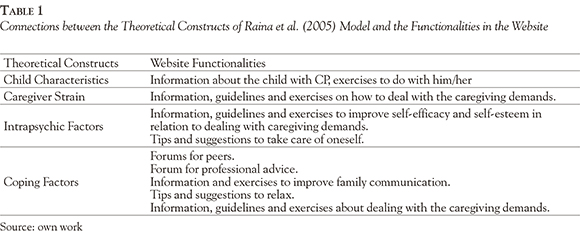
The objective of this paper is to present a preliminary study of a website aimed at improving quality of life of parent-caregivers of children with cerebral palsy. To do this, we first present an overview of the design of the website; second, we outline the psychological support it offered aimed at improving the quality of life of caregivers; and finally, as a pilot study to test the website, we present preliminary data obtained from a questionnaire given to 10 users on the usefulness of the different sections of the site.
Website description
As we have seen, the "Calidad de vida en cuidadores de niños con parálisis cerebral (CVCNPC)" website (translated as "Quality of life in caregivers of children with cerebral palsy") was developed in accordance with scientific literature about caregivers' quality of life, including burden and stress. Effective caregiv-er skills were first identified, and those including communicating effectively, learning to relax, taking care of oneself, coping strategies, awareness of your child's situation, and social support (See Table 1, Table 2, and Figure 1). The interactive features accommodate different caregivers' needs and allow caregivers to choose different pathways based on their own needs.
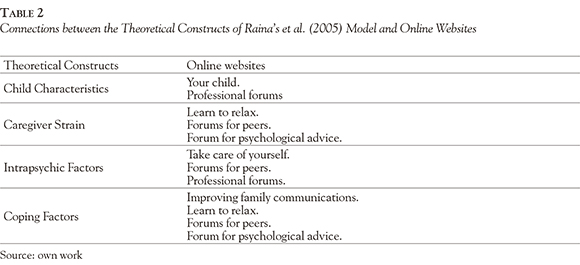
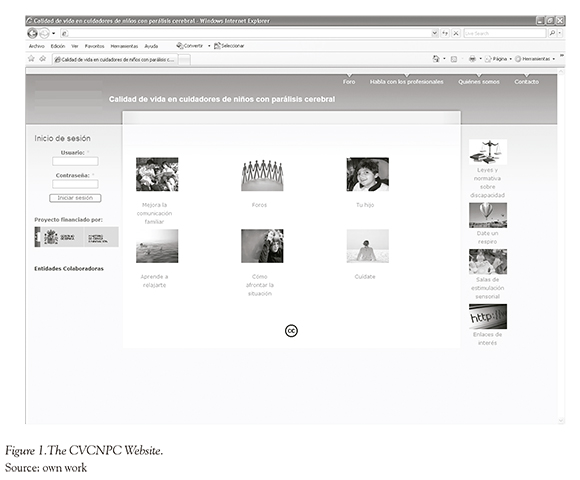
The homepage featured buttons that, when clicked, took participants to resources, guidelines, exercises, etc. Next to these buttons, participants were able to access peer-to-peer forums and professional forums.
CVCNPC addresses caregivers through structured, self-guided web pages and asynchronous one-on-one or multiple communication with other caregivers, and all participants could access the same functionalities in any sequence. This website takes advantage of the ability of computers to store and present information interactively in a variety of ways, based on user's particular needs. For example, a mother might always access the relaxation exercises and ignore the other on-line pages. Thus, this website was standardized and can be tailored to individual needs.
Improving Family Communication
Family functioning plays an important role in well-being and is determined, to a great extent, by effective communication.
When a family member has a chronic disease, all members need a great amount of support but, at the same time, it is precisely during this period when helpful communication can be more difficult. This site was intended as a space for learning and practicing communication skills: listening to family members, expressing what you feel and what you want, and looking for right moments to communicate with each other. Each of these skills is developed through some guidelines and exercises that deal with some basic rules and advice, and family members are free to do them as many times as they want. This site includes an introduction and contextualizes each exercise or practice to be accessible and understandable for both family members and secondary participants (see Figure 2).
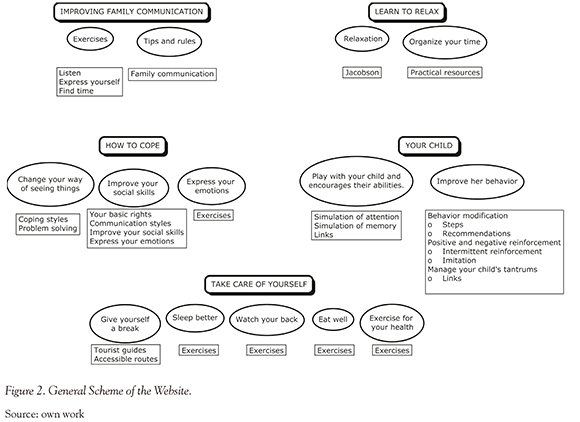
Learning to Relax
Another important ability for the caregivers is to be able to manage stress, while also trying to take care of a child with CP. On the site users can find easy ways and recommendations to reduce daily stress. There are two main sections: relaxation and time management. With regard to relaxation, the technique outlined is Jacobson's progressive muscle relaxation. Relaxing will not solve problems, or take away what is worrying, but it will help one to look at a situation from another perspective, and it can also help in coping with the situation free from anxiety (see Figure 2). Regarding time management, a number of exercises are included to help participants learn strategies for prioritizing activities, delegating responsibilities, and learning to say no. Thus, participants can repeat these exercises over and over until they have adopted them as a routine.
How to Cope
It is highly recommended that everyday situations be addressed in the healthiest way possible. In this part of the website, there are recommendations and exercises to choose those alternatives that are sometimes simpler, easier, or just more helpful. In particular, the following sections can be found: "change your way of seeing things", "improve your social skills", and "express your emotions". Again, the content in each section is developed through guidelines and exercises (see Figure 2).
Your Child
All the other sections of the website are addressed to the caregivers, but this section is addressed to the son or daughter with CP and their parents, all of them together.
Thus, parents of children with CP can find recommendations for introducing play with their children, in order to improve their cognitive abilities, modify unsuitable behaviors, and manage tantrums. As noted earlier, many exercises are available in different grades of difficulty (see Figure 2).
Take Care of Yourself
A parent that has to care for their child with CP must be in top physical and mental condition, and in this section the caregiver can find strategies and exercises to improve their fitness (see Figure 2).
Complementary Resources
The website also includes resources on CP, not so much about the disorder itself, but information directed at caregivers. Therefore, and assuming that parents understand the disorder quite well, this section is aimed at providing them with details regarding disability laws and legislation, sensory stimulation and useful links.
Social Support Forums
As already mentioned, the website arose from a previous theoretical model and with the participation of key informants: parent-caregivers of children with CP. From both perspectives, we saw it as vitally important that the site should have an online communication or community space for users; therefore it was established as a forum for peer-to-peer exchange. This forum has restricted access and parents can participate freely and at any time.
This forum or online community has shared generic objectives that were outlined at the beginning of the intervention, and the concern of good practice among an online community (writing messages, recommendations about usage of the forum, etc.). The forum is moderated by a facilitator who is paid for carrying out this task and is known for having experience in the field of children with CP.
Apart from the community of peers, three other forums were available under the heading "Talk to the professionals ", in which a physiotherapist, a psychologist and social worker participated (See Figure 2).
Monitoring Tools
We used two tools for monitoring the website: 1) Google Analytics was used to monitor access to the site. This tool gave us rich insights about the website traffic, we could access a graph showing the number of hits on the Website throughout each day, and the sites most visited by users (see Figure 3). 2) The platform was built on Drupal, a content management system (CMS). Drupal enables one to develop a platform with dynamic content. Our platform is hosted in a UOC server under the Linux Ubuntu operating system, which stores all own generated data in a MySQL database. SQL queries allow us to search through log tables on the platform database to obtain information on the connection habits and activity of users. One of the main differences between data from Google Analytics and the platform database is personalization. While Google analytics only provides anonymous information about connections, such as volume and location, the database allows us to obtain personalized data for each user.
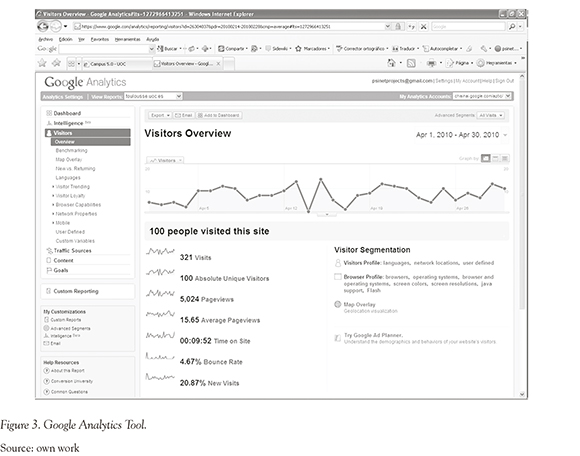
Method
Participants
A convenience sample of caregivers of children with cerebral palsy (CP) was recruited for this pilot study on the usefulness of the website. They were contacted and invited to participate through different Spanish associations and communities of people affected with CP and their caregivers. Caregivers who met the following inclusion criteria were invited to participate: (1) to be the father or mother of a child with CP (aged less than 18 years) and (2) to be the main caregiver (whichever of the two parents attributed to themselves a percentage of care greater than 50%), (3) to be a regular user of the website (get into the website more than 10 times in 5 months). Finally, participants of the pilot study were 10 caregivers of children with CP who participated and completed a questionnaire to analyze the usefulness of this website.
Nine were mothers and one was a father. Their average age was 40.4 (SD = 5.6). The age of their children was 2-11 years with a mean of 6.7 years (SD = 3.05), with 50% below 6.5 years. A majority of children (70%) had physical impairments and required adult assistance. Data acquired from the monitoring tools showed that all participants were regular users of the website and contributed to its forums (the median of time spent on the website was 44 hours and the median number of total contributions to forums was 9).
Measures
The following instruments were used to assess the usefulness of the website:
Useful Questionnaire
In this instrument we quantitatively assessed (from 1, low, to 10, high) the usefulness of the 14 different sections of the website and also the time spent by the on each section. Additionally, we qualitatively assessed participants' opinion with 3 open questions: the first asked them for 5 positive aspects of the website, the second for 5 negative aspects, and the third for anything else they wished to add.
Professional Evaluation
After the intervention, we sent a questionnaire to the professionals who had worked on the website. The questionnaire aimed to assess their satisfaction with the site, and to find out what they thought to be its most significant positive and negative aspects. It consisted of four open questions: How do you rate your work in your professional forum? Were you able to respond to the demands of the users? What were the strengths and weaknesses of your forum? and What do you think are the strengths and weaknesses of the platform?
Procedure
Prior to launch, the website was tested for usability by 4 independent volunteers, who didn't know the website previously, and we obtained the first definitive version of the website CVCNCP 1.0, which was used in the present study. We contacted parents of children with CP through Spanish associations of CP (e.g. ASPACE). Once the users voluntarily agreed to participate, they were given access to the website and all signed the informed consent, which was approved by the Ethics Committee of the Uni-versitat Oberta de Catalunya.
Users could decide which sections they wanted to visit and in what activities they could participate. After 5 months of participation, we sent the questionnaire by e-mail about the usefulness of the website. Additionally, after the intervention phase, we collected opinions of the three professionals (physiotherapist, psychologist and social worker) by asking them the four questions presented in the instruments section.
All quantitative analyses were done using the statistical package SPSS (version 16.0) and content analysis of qualitative data was carried out using ATLAS.ti 6.2.
Results
Quantitatively, results suggested that, in general, participants found the website to be very useful. The median values of usefulness were between 6 and 10 points (80% between 8-10 points). Figure 4 shows the data box plots and Table 3 shows the mean, standard deviation and median of items. We calculated the median values as they are less sensitive to extreme scores than the mean.
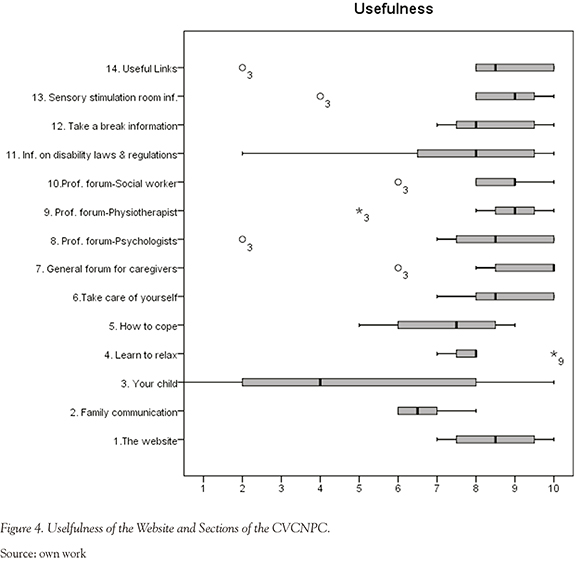
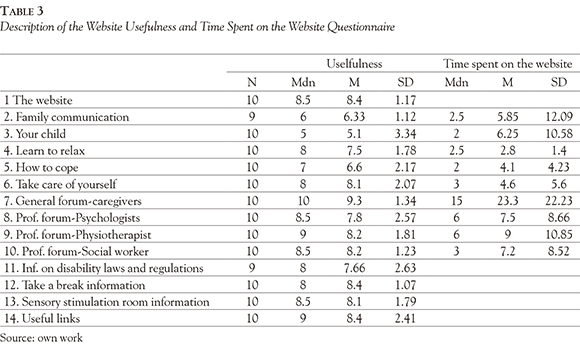
Results clearly show that the most useful sections of the CVCNPC were the forums. Of these, the most highly valued was the general forum for caregivers ( Mdn = 10), followed by the forums for contacting professionals: Physiotherapist (Mdn = 9), Psychologist (Mdn = 8.5), and Social Worker (Mdn = 8.5). The section "useful links" was also highly valued ( Mdn = 9). We found more varied responses regarding the sections that were less valued by participants; these included "your child" ( Mdn = 5), "family communication" ( Mdn = 6) and "how to cope"(Mdn = 7). If we look at the sections where study participants spent more time, results are positively related to use, as it is logical that users spent more time on what they found most useful.
A content analysis of qualitative results sheds light on the positive and negative aspects of the website. The summary found in Figure 5 shows that aspects that were rated and commented on by all study participants were ability "share experiences, concerns and feelings with your peers" and to "consult with the professionals'. Following which, aspects related to "enrichment of information" and "the convenience of being able to access from home, without timetables", were also highlighted.
The aspects valued least were mostly closely related to usability and design of the website: "lacks pictures, videos and color", "difficultly accessing the forums". We had similar findings with regard to some specific sections of the website, namely the difficulty of some exercises in section "your child". Both of these issues are reflected in the quantitative results.
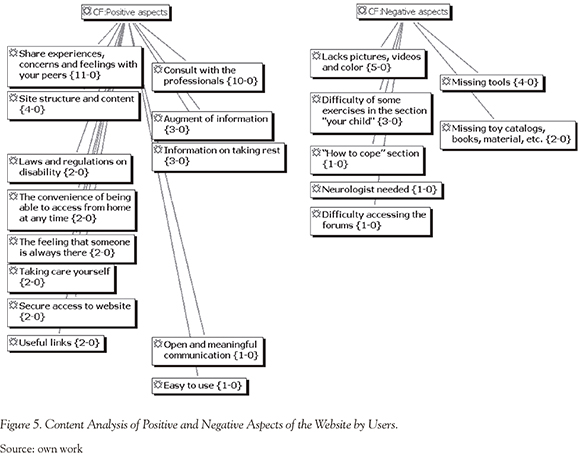
Professionals evaluated the initiative as extremely positive (see Figure 6). They considered their participation as an opportunity to get closer to participants, and that the CNCVCP allowed them to provide a very good service to users. All of them appreciated the accessibility of the website, which was achieved through the well-elaborated content and forums for participation. At the same time, however, they highlighted the technical limitations of the website, especially for creating and following threads of discussion in the forum, and the difficulties in sharing pictures and other sources.
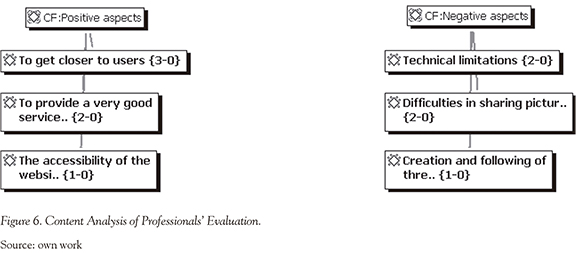
Finally, with regard to comments that participants wanted to add to the questionnaire, these were mainly for congratulations on the project e.g.: "Thank you so much for creating this website and for giving us the opportunity to participate", "I think this website is a great support for parents and, therefore, for our children, allowing us to share our day to day lives, our feelings, our concerns and joys with people who really understand us. And even for sharing "tricks" or strategies for the care of children or to help make the situation better".
Discussion
Parent caregivers of children with CP can get support from a website tailored to their physical and, above all, psychological needs (Lin, 2000; Taanila, Syrjälä, Kokkonen, & Järvelin, 2002). It is therefore important to establish what those needs are and then translate them into a website, such as the CVCNCP we have presented.
The general opinion of the CVCNCP has been positive, leading us to think that the project, as an intervention aimed at improving the well-being and coping skills of parent-careegivers (Sorensen, Pinquart, & Duberstein, 2002) is meeting a real need of users and provides benefits to them (Wicks et al., 2010).
Similarly, the valuation obtained for the general forum for caregivers is consistent with the theoretical model from which we started: caregivers need support elements to address their situation, and for this a key element is peer support. These results are also consistent with other recently published works (Stewart, Letourneau, Masuda, Anderson, & McGhan, 2011) in which parents said they felt alone and wanted support from others in similar situations, or where a high percentage of participants reported positive comments on the peer online support forum (Meredith, Grabinski, & Dallery, 2011).
Similarly, the professional forum was also very much appreciated. The psychologist, physiotherapist and social worker provided users with detailed and specialized information, accessible any time and from anywhere. They also responded to questions raised by users at a more individual level. Without doubt, one of the added values of our website has been having professional support,something that doesn't happen in other social networks. On our website, there have been two types of support: peer-to-peer and professional. This idea is consistent with that provided by the Pew Internet report on peer support (Peer to peer healthcare by Fox, 2011), according to which persons associated with chronic diseases seek peer support (personal, practical, emotional and linked to the experience of illness), as well as professional (for technical/ medical aspects of the illness); clearly identifying the type of support sought in each case.
On the part of the professionals, they reported the initiative as being extremely positive. They considered their participation to be an opportunity to get closer to users, and that the CNCVCP has allowed them to provide a very good service to them. Altogether, they appreciate the accessibility of the website, from the extensive content to the participatory forums. However, they pointed out some technical limitations of the website (especially the creation and following of threads of discussion in the forum, and some difficulties in sharing pictures and other resources).
On the other hand, we would stress that the section "how to deal with the situation" raised expectations that have only been partially fulfilled. Additionally, some of the negative scores given to the section "Your child" have made us rethink the need to adapt the contents of each section of the website to each individual case and the degree of difficulty of some of the exercises. This personalized component however, was present in the forums, where professionals and peers responded accordingly to the consultation and/or comment of each user. This contributed to the perception of social support and competence of the parents as they deal with the caring situation. In fact, both social support and perceived self-efficacy (defined as the ability to self-care, to obtain respite when needed, to respond to disruptive behaviors, to control upsetting thoughts an negative feelings) are basic elements related to the quality of life of caregiving parents of children with chronic illness (Florian & Findles, 2001; Manuel, Naughton, Balkrishnan, Paterson, & Koman, 2003; Márquez-González, Losada, López, & Peñacoba, 2009; Skok, Harvey, & Reddihough, 2006).
Results of this project suggest that through a tailored website that offers opportunities for social interaction we can help fulfill the needs of caregivers. However, further research is needed to identify variables that are affected by an intervention such as this one, and to further clarify if — and how — it actually improves the quality of life of caregivers.
Limitations
The current study has a number of limitations. The first limitation is that it is a pilot study with a limited number of participants. The sample size is small and may have affected the strength of results. It would be necessary to replicate this study to confirm whether the trends observed are also found in larger samples. Consequently, drawing conclusions regarding other types of participants should be done with caution.
A second limitation is related to participants' adherence to the intervention. They did not access the website continuously, so for this reason it is difficult to evaluate its efficacy. Therefore, in order to further confirm the findings of the current study, it may be necessary to include a sample that would participate in an intervention on a more continuous basis.
A third limitation of the study is that we did not include socio-economic factors. In previous research related to the effects that stress has on the health and welfare of people, their economic status seems to be a very important predictor (McEwen & Gianaros, 2010). However, a study by Raina et al. (2005) found that the impact of such factors on the health and psychological well-being of parent care-givers of children with CP was very weak. For future studies, researchers could further examine the role of socio-economic factors and their impact on the well-being of participants in an online intervention.
Finally, research in this area must take into account possible differences between fathers' and mothers' adaptation to their child's difficulties. It would also be interesting to explore whether there are differences in this process according to the sex of the child, and how this might impact on other family members, such as siblings or grandparents, who have rarely been studied in this population.
References
Blair, E. (2010). Epidemiology of the cerebral palsies. Orthopedic Clinics of North America, 41(4), 441-455. [ Links ]
Brehaut, J. C., Kohen, D. E., Garner, R. E., Miller, A. R., Lach, L. M., Klassen, A. F., & Rosenbaum, P. L. (2009). Health among caregivers of children with health problems: Findings from a Canadian population-based study. American Journal of Public Health, 99(7), 1254-1262. [ Links ]
Campbell, M., Fitzpatrick, R., Haines, A., Kinmonth, A. L., Sandercock, P., Spiegelhalter, D., & Tyrer, P. (2000). Framework for design and evaluation of complex interventions to improve health. British Medical Journal, 321(7262), 694-696. [ Links ]
Craig, P., Dieppe, P., Macintyre, S., Michie, S., Nazareth, I., & Petticrew, M. (2008). Developing and evaluating complex interventions: The new medical research council guidance. British Medical Journal, 337(7676), 979-983. [ Links ]
Davis, E., Shelly, A., Waters, E., Boyd, R., Cook, K., Davern, M., & Reddihough, D. (2010). The impact of caring for a child with cerebral palsy: Quality of life for mothers and fathers. Child Care Health Development, 36(1), 63-73. [ Links ]
Florian, V., & Findles, L. (2001). Mental health and marital adaptation among mothers of children with cerebral palsy. American Journal of Ortopsychiatry, 71(3), 358-367. [ Links ]
Fox, S. (2011). Peer-to-peer healthcare (Report). Washington, DC: Pew Internet California/ Healthcare Foundation. Retrieved from http://pewinternet.org/Reports/2011/P2PHEalthcare.aspx [ Links ]
Glueckahuf, R. L., & Noël, L. T. (2011). Telehealth and family caregiving: Developments in research, education, policy and practice. In R. W. Toseland, D. H. Haigler & D. J. Monahan (Eds.), Education and support programs for caregivers (pp. 85-106). New York: Springer. [ Links ]
Grootenhuis, M. A., & Bronner, M. B. (2009). Paediatric illness! Family matters. Acta Pediatrica, 98(6),940-941. [ Links ]
Guillamón, N., Armayones, M., Hernández, E., & Gómez, B. (2010). The role of patient organizations in participatory medicine: Can virtual health communities help participatory medicine accomplish its objectives? Journal of Participatory Medicine, 29, 2:e21. Retrieved from http://www.jopm.org/evidence/reviews/2010/12/29/the-role-of-patient-organizations-in-participatory-medicine-can-virtu-al-health-communities-help-participatory-medicine-accomplish-its-objectives/print/ [ Links ]
Jadad, A., Enkin, M., Glouberman, S., Groff, P., & Stern, A. (2006). Are virtual communities good for our health? BritishMedicalJournal, 332(7547), 925-926. [ Links ]
Leimeister, J. M., & Krcmar, H. (julio, 2005). Evaluation of a systematic design for a virtual patient community. Journal of Computer-Mediated Communications, 10(4). doi/10.1111/j.1083-6101.2005.tb00269.x [ Links ]
Lin, S. L. (2000). Coping and adaptation in families of children with cerebral palsy. Excepcional Children,66(2), 201-218. [ Links ]
Manuel, J., Naughton, M. J., Balkrishnan, R., Paterson, S. B., & Koman, L. A. (2003). Stress and adaptation in mothers of children with cerebral palsy. Journal of Pediatric Psychology, 28(3), 197-201. [ Links ]
Márquez-González, M., Losada, A., López, J., & Peñacoba, C. (2009). Reliability and validity of the Spanish version of the revised scale for caregiving self-efficacy. Clinical Gerontologist, 32(4), 347-357. [ Links ]
McEwen, B. S., & Gianaros, P. J. (2010). Central role of the brain in stress and adaptation: Links to socioeconomic status, health, and disease. Annals of the New York Academy of Sciences, 1186, 190-222. http://dx.doi.org/10.1111/j.1749-6632.2009.05331.x [ Links ]
Meredith, S., Grabinski, M., & Dallery, J. (2011). Internet-based group contigency management to promote abstinence from cigarette smoking: A feasibility study. Drug and Alcohol Dependence, 118(1), 23-30. [ Links ]
Michie, S., & Prestwich, A. (2010). Are interventions theory-based? Development of a theory coding scheme. Health Psychology, 29(1), 1-8. [ Links ]
Montorio-Cerrato, I., Izal, M., López, A., & Sánchez, M. (1998). La entrevista de carga del cuidador. Utilidad y validez del concepto de carga. Anales de Psicología, 14(2), 29-248. [ Links ]
Odding, E., Roebroeck, M. E., & Stam, H. J. (2006). The epidemiology of cerebral palsy: Incidence, impairments and risk factors. Disability and Rehabilitation, 28(4), 183-191. [ Links ]
Ostwald, S. K. (2009). Who is caring for the caregiver? Promoting spousal caregivers's health. Family & Community Health, 32(S1): S5-S14. [ Links ]
Pearlin, L. I. (1994). Conceptual strategies for the study of caregiver stress. In E. Light, G. Niederehe & B. D. Lebowitz (Eds.), Stress effects on family caregivers of Alzheimer's patients: Research and interventions (pp. 3-24). New York: Springer. [ Links ]
Pearlin, L. I., Mullan, J. T., Semple, S., & Skaff, M. M. (1990). Caregiving and the stress process: An overview of concepts and their measures. The Gerontologist, 30(5), 583-694. [ Links ]
Raina, P., O'Donell, M., Schawellnus, H., Rosenbaum, P., King, G., Brehaut, J., ... Wood, E. (2004). Care-giving process and caregiver burden: Conceptual models to guide research and practice. BMC Pediatrics, 4(1), 1-13. [ Links ]
Raina, P., O'Donnell, M., Rosenbaum, P., Brehaut, J., Stephen, D., Russell, D., . Wood, E. (2005). The health and well-being of caregivers of children with cerebral palsy. Pediatrics, 115(6), 626-636. [ Links ]
Schultz, R., & Salthouse, T. H. (1999). Adult development and aging: Myths and emerging realities. Upper Saddle River, NJ: Prentice Hall. [ Links ]
Skok, A., Harvey, D., & Reddihough, D. (2006). Perceived stress, perceived social support, and wellbeing among mothers of school-aged children with cerebral palsy. Journal of Intellectual & Developmental Disability, 31 (1), 53-57. [ Links ]
Sorensen, S., Pinquart, M., & Duberstein, P. (2002). How effective are interventions with caregivers? An updated metaanalysis. The Gerontologist, 42, 356-372. [ Links ]
Stewart, M., Letourneau, N., Masuda, J., Anderson, S., & McGhan, S. (2011). Online solutions to support needs and preferences of parents of children with asthma and allergies. Journal of Family Nursing, 17(3), 357-379. [ Links ]
Taanila, A., Syrjälä, L., Kokkonen, J., & Järvelin, M. R. (2002). Coping of parents with physically and/or intellectually disabled children. Child: Care, Health & Development, 28(1), 73-86. [ Links ]
Tucker, C. M., Butler, A. M., Loyuk, I. S., Desmond, F., & Surrency, S. L. (2009). Predictors of a health-promoting lifestyle and behaviours among low-income of chronically ill children. Journal of the National Medical Association, 10, 103-110. [ Links ]
Webb, T. L., Joseph, J., Yardley, L., & Michie, S. (2010). Using the internet to promote health behavior change: a systematic review and meta-analysis of the impact of theoretical basis, use of behavior change techniques, and mode of delivery on efficacy. Journal of Medical Internet Research, 12(1), e14. http://dx.doi.org/10.2196/jmir.1376 [ Links ]
Wicks, P., Massagli, M., Frost, J., Brownstein, C., Okun, S., Vaughan, T., . Heywood, J. (2010). Sharing health data for better outcomes on Patients-LikeMe. Journal of Medical Internet Research, 12(2), e19. http://dx.doi.org/10.2196/jmir.1549 [ Links ]
Yates, M. E., Tennstedt, S., & Chang, B. (1999). Contributors to and mediators of psychological well-being for informal caregiver. The Journals of Gerontology,54B, 12-22. [ Links ]













